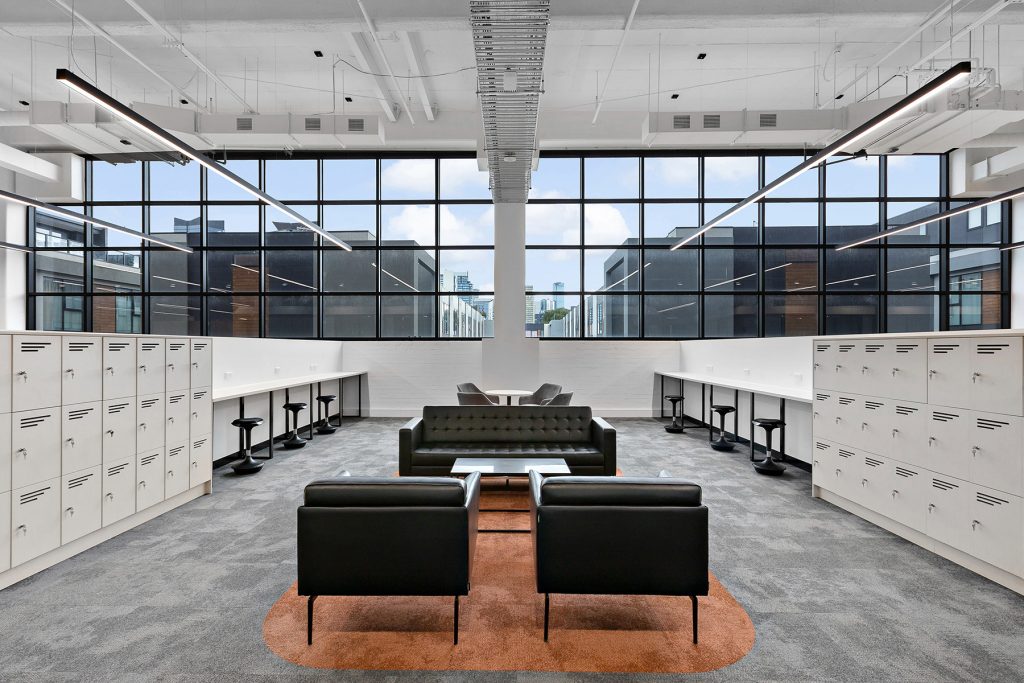Flexible Workspaces: Embracing Versatility and Adaptability
Flexible workspaces have gained significant traction in recent years. Departing from the rigid confines of traditional cubicles and fixed desks, flexible workspaces provide an array of benefits that align with the diverse work styles and preferences of today’s professionals. Here’s why flexible workspaces are revolutionizing office design:
- Activity-Based Work Areas: Creating spaces that cater to various work styles and tasks is paramount. We introduce quiet zones for focused work, collaborative areas for brainstorming, and comfortable lounges for informal meetings. This empowers employees to choose environments that resonate with their needs, ultimately fostering creativity and productivity.
- Hot-Desking and Shared Spaces: Promoting flexibility and collaboration, hot-desking eliminates assigned seating and empowers employees to choose their workstations based on daily requirements. Shared spaces, such as communal tables and breakout areas, encourage interaction and idea exchange among team members.
- Modular Furniture Solutions: Investing in adaptable and modular furniture equips the workspace to evolve alongside changing needs. Mobile partitions, adjustable desks, and flexible seating arrangements provide versatility and support evolving work dynamics.
Agile Office Layouts: Promoting Collaboration and Innovation
Agile office layouts prioritise collaboration, communication, and employee engagement. By breaking down physical barriers and fostering a sense of community, these layouts create an environment conducive to teamwork and creativity. Here’s how they are reshaping office design:
- Open-Plan Spaces: Embrace open-plan layouts that encourage communication and teamwork. Breaking down physical barriers fosters a sense of camaraderie and facilitates easy information exchange, driving collaboration and innovation.
- Collaboration Zones: Designate specific areas for collaboration, equipped with whiteboards, writable walls, and comfortable seating. These zones become the epicentre of idea generation and cross-functional teamwork.
- Huddle Rooms: Create small, private meeting spaces where teams can gather for quick discussions or brainstorming sessions. Equipped with audio-visual technology and interactive displays, these rooms enable seamless collaboration and decision-making.
Integration of Technology: Embracing the Digital Age
The integration of technology into the workspace is reshaping how we work. This fusion enhances productivity, efficiency, and connectivity, thereby transforming the traditional office landscape. Here’s how the integration of technology enhances the modern workspace:
- Smart Offices: Implement smart technologies such as devices, sensor-activated lighting, and automated climate control systems. These technologies optimise energy usage, enhance comfort, and streamline day-to-day operations.
- Digital Collaboration Tools: Embrace collaborative software, project management tools, and virtual meeting platforms that facilitate remote work and seamless communication among team members. These tools enable real-time collaboration and ensure teams stay connected, regardless of their physical locations.
- Tech-Enabled Workspaces: Incorporate wireless charging stations, integrated power outlets, and ergonomic accessories designed for digital devices. These features cater to the needs of a tech-savvy workforce and support seamless integration between digital tools and the physical workspace.
If you have any questions or would like to explore how these trends can be tailored to your industry and specific needs, we’re here to provide guidance and expertise. Whether you’re embarking on a complete commercial fit-out or seeking to revamp specific areas, our expertise and industry knowledge ensure that your office design aligns with the latest trends and reflects your unique organisational goals.
Let’s shape the future of your workspace together,
Aquilla Interiors







